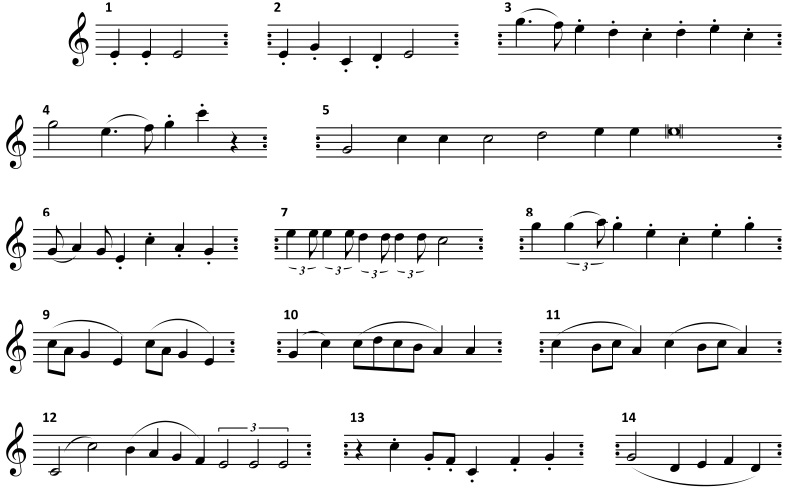In Season,
by
Michael Monroe
(2014)
This little piece is based closely on Terry Riley's iconic In C, which was written fifty years ago in 1964. The "rules" for performing this homage are pretty close to Riley's. The main differences are that this piece only has 14 patterns, as opposed to Riley's 53, and the patterns here are all familiar as brief excerpts from well-known tunes. This does change the effect to a significant degree, both because most of these patterns have clearer melodic profiles than most of Riley's more elemental patterns, and because recognizing the patterns becomes an important part of the listening experience. Riley's piece relies on the relative anonymity of the patterns, which probably makes it easier for them to coalesce into new musical ideas. New ideas can and will still emerge in this "seasonal" context, but the ideas won't merge quite as easily since there are simply more pitches and varieties of intervals and rhythms in play.
One result of this is that, whereas Riley says a "group of about 35 is desired if possible but smaller or larger groups will work," this piece will likely function best with smaller groups, with about 10 as ideal, simply because there's more inherent complexity in mixing up these melodies. By the way, please note that in addition to the familiar tunes, the soundworld of Riley's familiar classic should also emerge as a recognizable building block for this mashed up medley.
Here are most of Riley's Rules with adjustments noted in bold underline.
- The ensemble should be aided by the means of a quarter note pulse played on the high C's of the piano or on a mallet instrument.
- All performers play from the same page of 14 melodic patterns played in sequence. Performers may begin at any time once the pulse has started, and may end at any time once arrived at #14. Once all other performers have ended, the pulse can end at any time.
- Any number of any kind of instruments can play. A group of about 10 is desired if possible but smaller or larger groups will work. If vocalists join in they can use any vowel and consonant sounds they like. (No words please, even if you know them!)
- Patterns are to be played consecutively with each performer having the freedom to determine how many times he or she will repeat each pattern before moving on to the next. Feel free to add rests as desired between repetitions of a pattern.
- There is no fixed rule as to the number of repetitions a pattern may have; however, since performances normally average between 5 and 15 minutes, it can be assumed that one would repeat each pattern 5-10 times or more.
- It is very important that performers listen very carefully to one another and this might mean occasionally to drop out and listen.
- Each pattern can be played in unison or canonically in any alignment with itself or with its neighboring patterns. One of the joys of In Season is the interaction of the players in polyrhythmic combinations that spontaneously arise between patterns. Some quite fantastic shapes will arise and disintegrate as the group moves through the piece when it is properly played.
- It is important not to hurry from pattern to pattern but to stay on a pattern long enough to interlock with other patterns being played. As the performance progresses, performers should stay within 2 or 3 patterns of each other. It is important not to race too far ahead or to lag too far behind.
- The tempo is left to the discretion of the performers, obviously not too slow, but not faster than performers can comfortably play.
- All performers must play strictly in rhythm and it is essential that everyone play each pattern carefully.
- It is OK to transpose patterns by an octave, especially to transpose up. Transposing down by octaves works best on the patterns containing notes of long durations. Augmentation of rhythmic values can also be effective.
|


